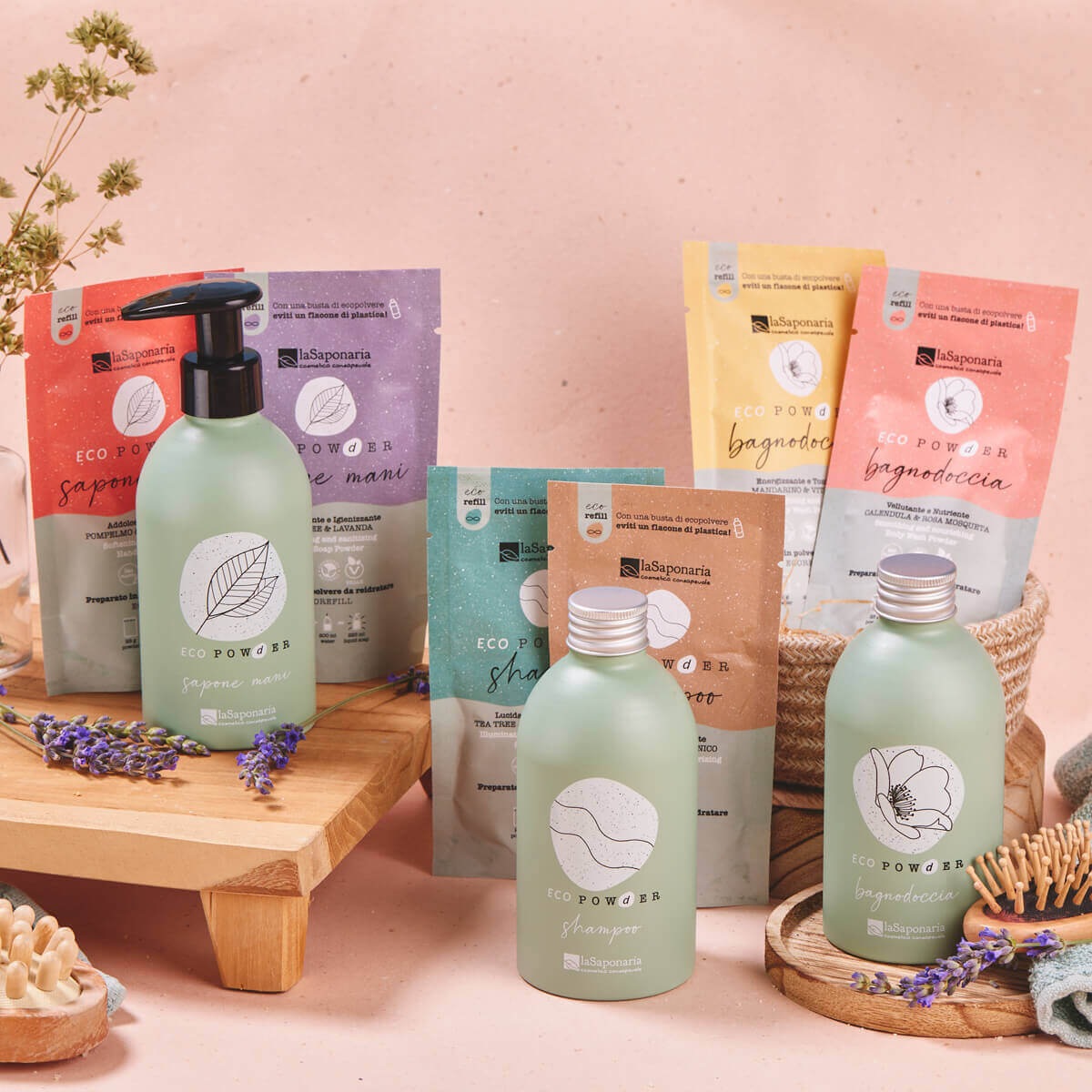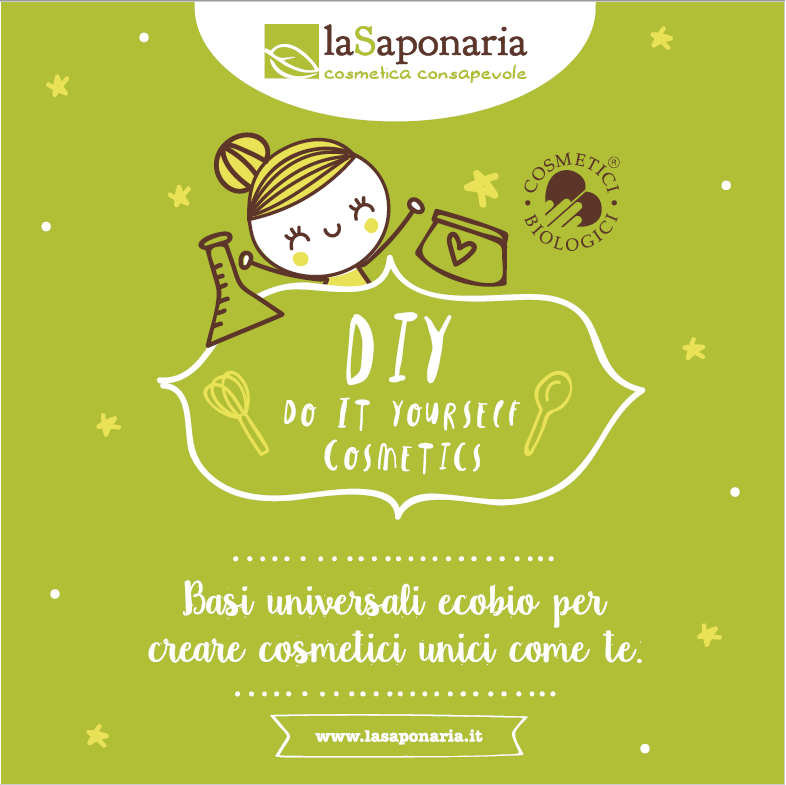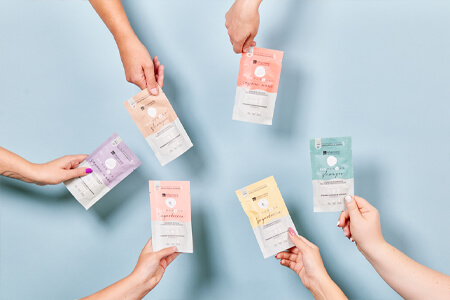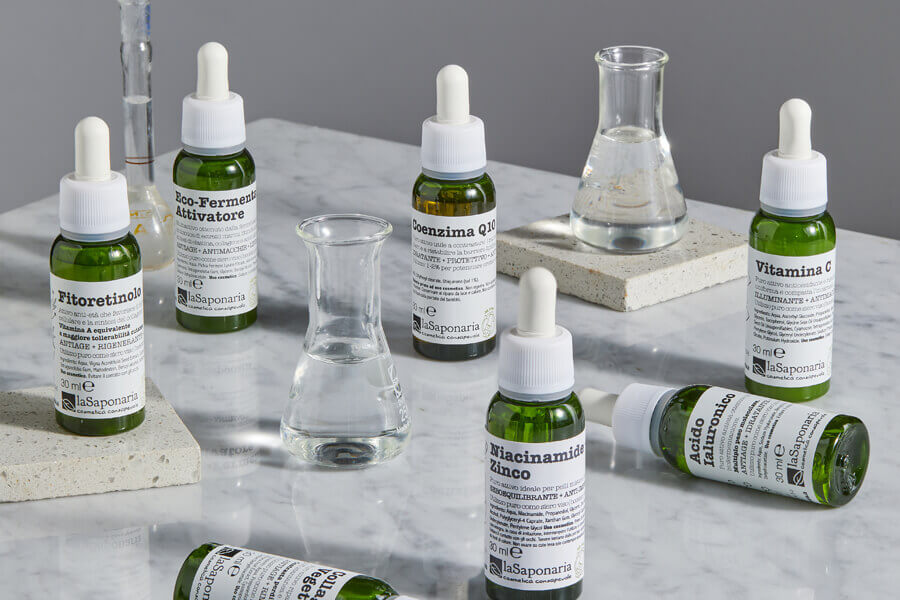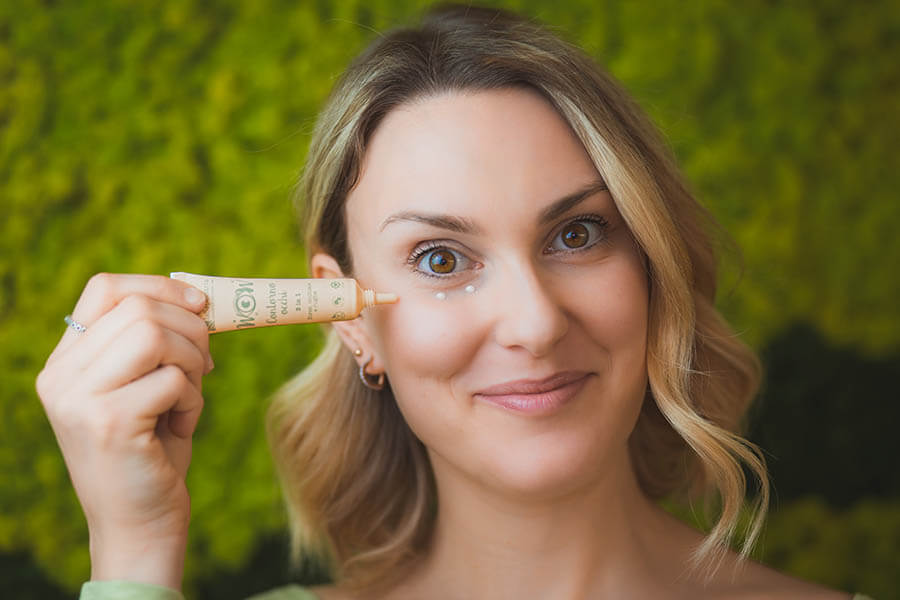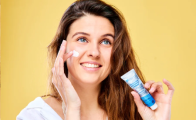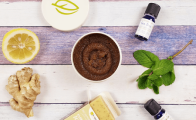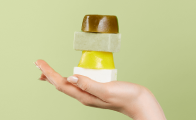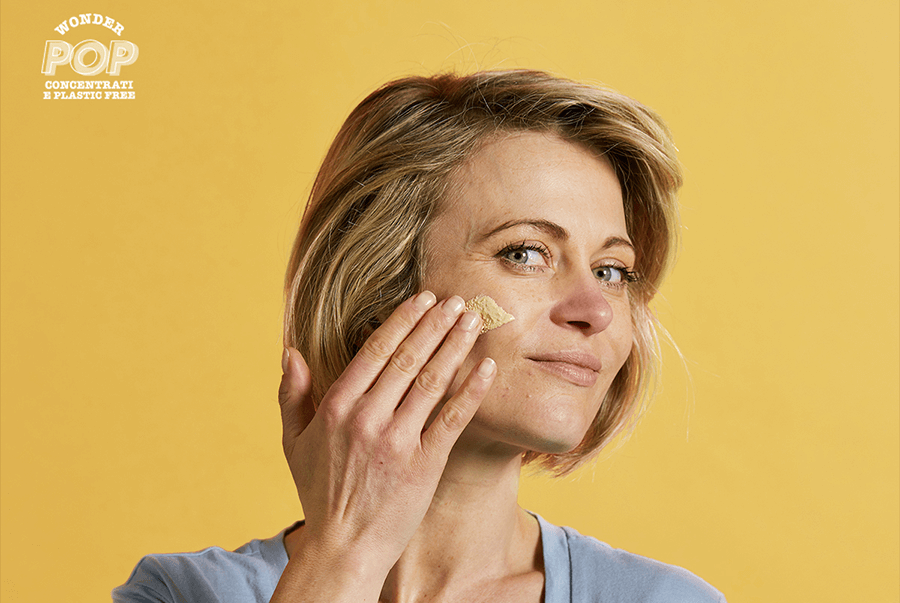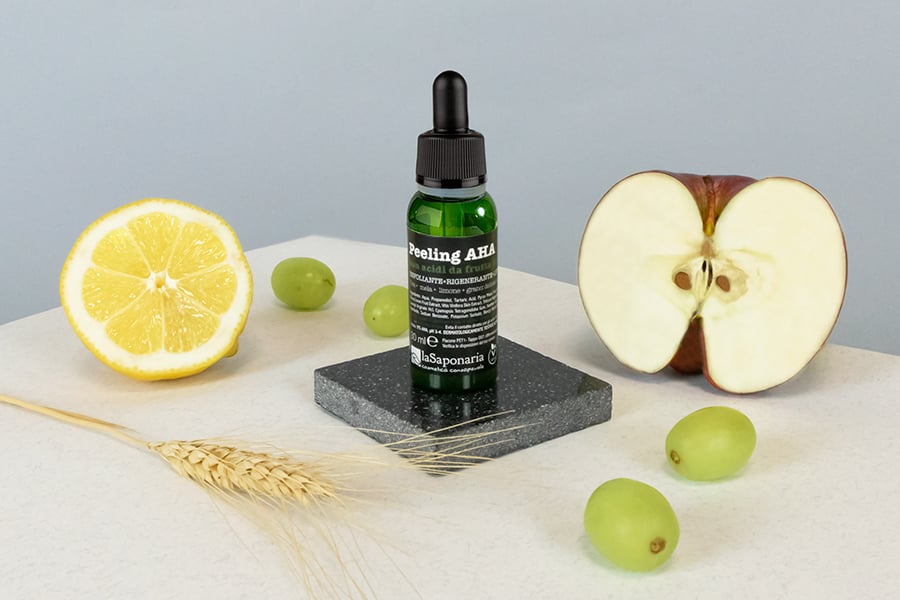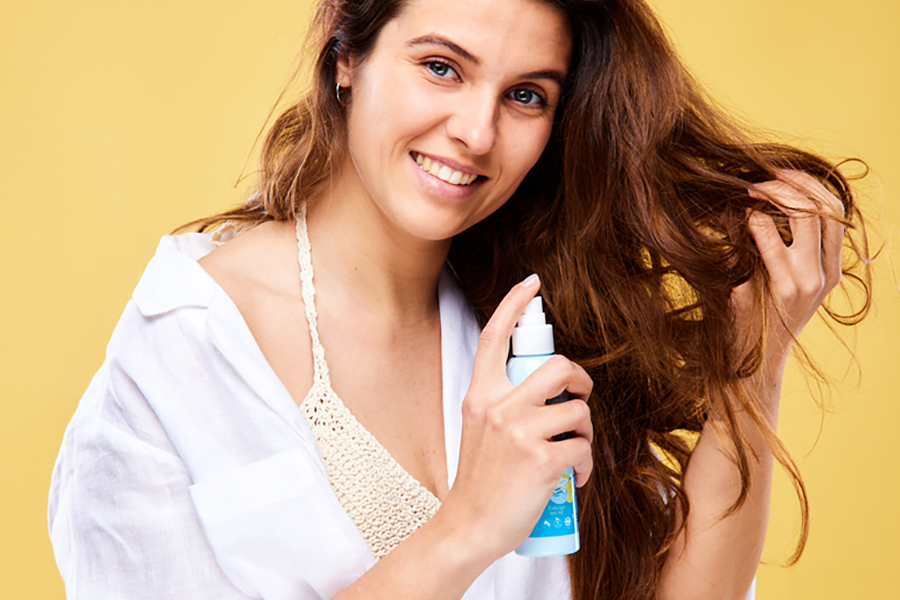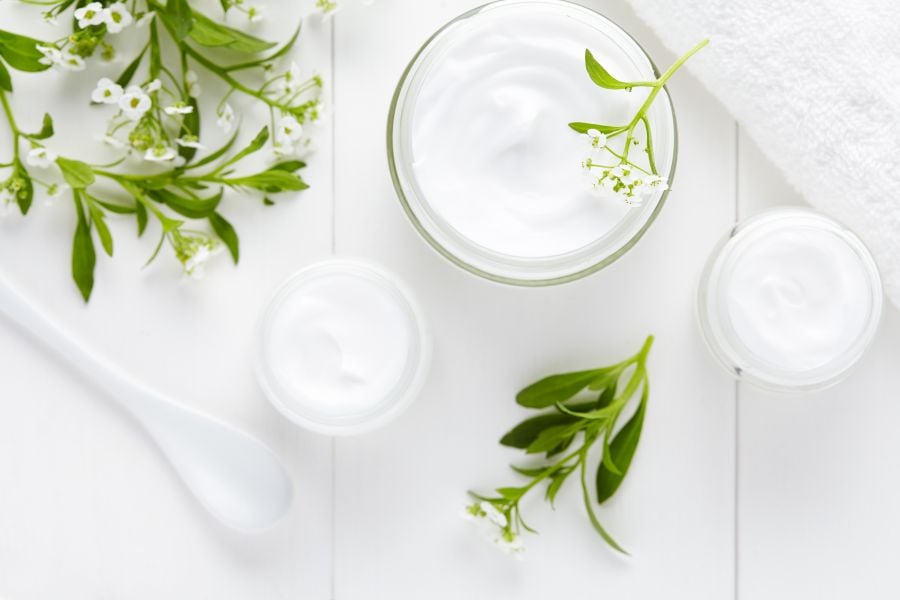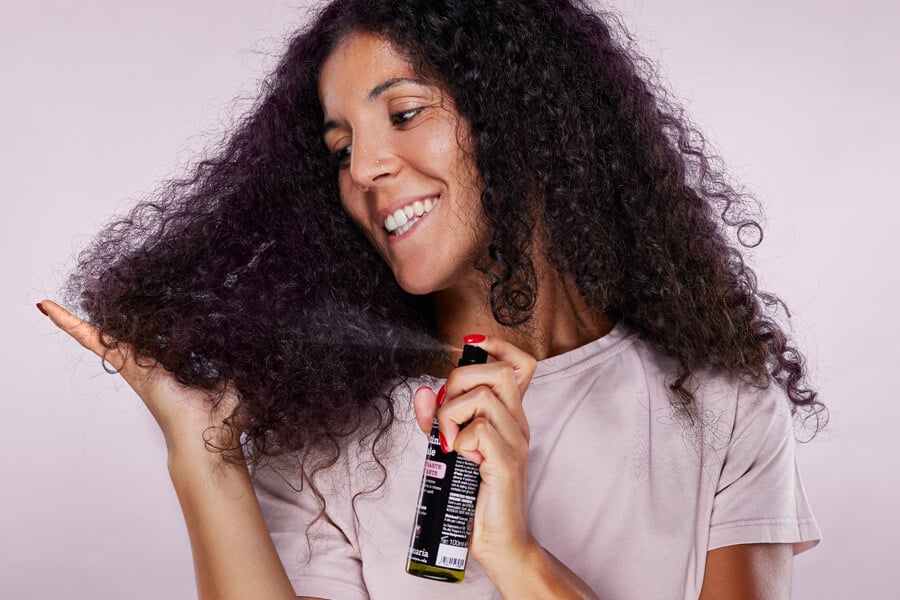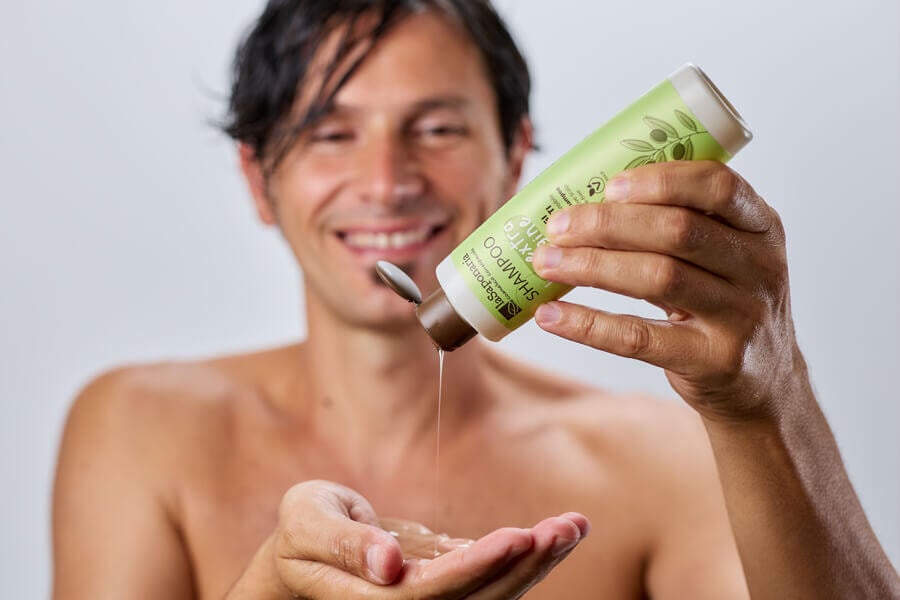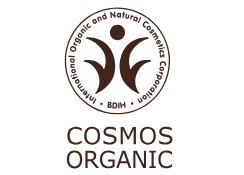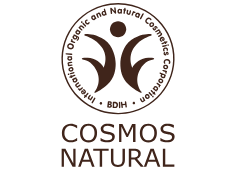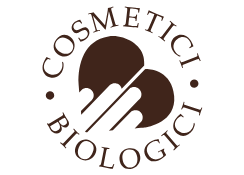The insights of La Saponaria
How to gently exfoliate facial skin: scrubs and peeling
One of the steps of a proper beauty routine should never be without exfoliation, the beauty treatment that stimulates cell turnover, providing deep cleansing and smoother, brighter and firmer skin!
Cleansing the skin daily and pampering it with toners, serums and creams is sometimes not enough for a smooth and radiant complexion. It would be nice if we could change our skin like snakes do and get rid of dead cells and greyness once and for all!
Exfoliation can come to our aid in such cases, but what does exfoliation mean?
Exfoliation: what it is and how it is done
Exfoliating the skin means acting on a very specific layer of our skin known as the stratum corneum, the outermost portion of the epidermis. The stratum corneum is in turn composed of several layers of dead cells - also known as corneocytes - that are flattened and have no nucleus.
Contrary to what one might think, dead cells perform many essential functions for our body, not least by helping to protect us from harmful UV radiation.
Why then do we want to eliminate them at all costs? Certainly because of the poor appearance that superficial corneocytes give our complexion. In fact, we should not target all the layers of dead cells, but only the most superficial ones.
In fact, the bonds that hold the corneocytes on the surface together are particularly weak in nature and tend to break easily, causing continuous peeling of the skin. Proceeding instead towards the underlying layers of corneocytes we find stronger and more resistant bonds that allow the cells to have a more compact appearance.
Skin exfoliation therefore takes place according to a cyclical rhythm in which each fallen cell is replaced by the one underneath: this is an entirely natural process that allows the stratum corneum to renew itself completely every 28 days or so.
Exfoliating treatments aim to accelerate the natural process of skin renewal by stimulating cell turnover. This helps eliminate superficial dead cells, responsible for the rough, greyish appearance of the skin.
The aim is therefore to achieve a complexion that is pleasing to the touch and to the eye, but why is it essential to encourage this process? Can we not simply wait for the skin to renew itself?
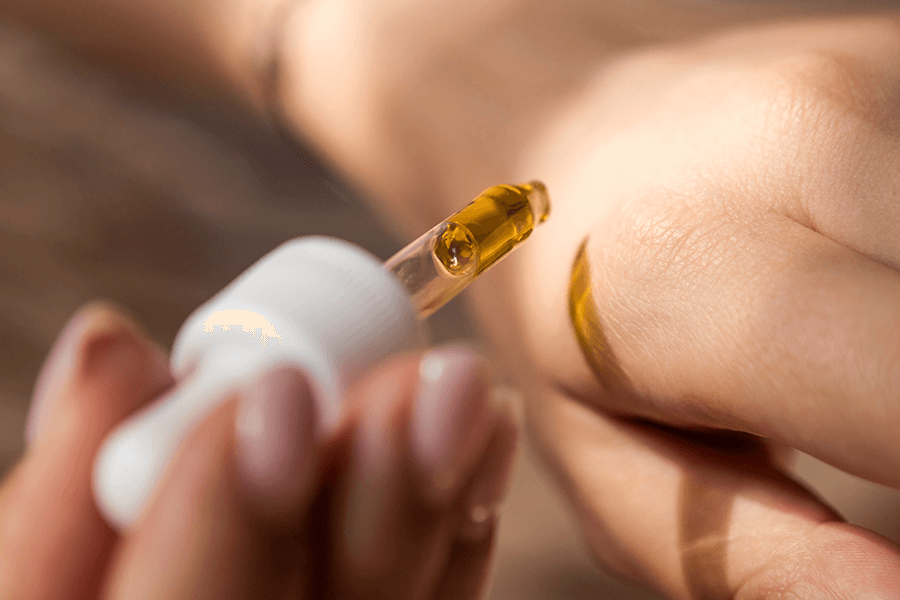
Why is it so important to exfoliate the skin?
Our facial skin is subjected daily to numerous sources of stress that affect its health, particularly damaging the stratum corneum, a favourite target of smog, UV rays and external agents of various kinds.
Hormonal factors or the use of cosmetics unsuitable for our skin type can also make our skin appear less beautiful and affect the cell turnover process, slowing it down.
Mature skin also tends to have a slower than normal skin turnover and therefore requires more frequent but also gentler exfoliating treatments: with the passage of time, the skin thins out and an exfoliator that is too powerful may cause more harm than good.
Speaking of benefits: exfoliating the skin removes impurities, accumulated dirt and removes the outermost layer of dead skin cells to reveal the firmer, brighter skin underneath.
By acting on skin thickening, exfoliants are then able to smooth expression lines, smooth wrinkles and stimulate fibroblasts by inducing the production of new elastin and collagen. The result is a toned, firm and younger-looking skin.
By removing the superficial layer of dead cells, exfoliation facilitates the penetration of functional substances and active ingredients in the cosmetics we apply later. In short, exfoliants act as true beauty enhancers!
How do you exfoliate your skin?
There are now various types of exfoliating products on the market to meet different needs so that all skin types can find the perfect exfoliator for their needs!
For simplicity's sake, we can divide exfoliants into two macro categories:
- mechanical scrub: removes corneocytes by abrasion and is characterised by a grainy consistency. It is activated by manual massage.
- enzyme exfoliant: is formulated with enzymes such as papain, bromelain, cocoa, red fruits, pumpkin. It acts deeper than a mechanical scrub.
- chemical exfoliant: harnesses the power of acids to 'loosen' the bonds between dead cells and promote cell turnover.
Mechanical scrub: how it works and for whom it is indicated
Let's start with the most traditional of exfoliants, and the most intuitive, the mechanical scrub. This category includes all those compounds with a grainy consistency that rely on the power of micro-granules or particles of various kinds to remove all the surface dead cells that are in the process of falling off.
The scrubbing action is achieved by simply massaging the product into the cleansed skin, taking care to moisten the skin first so as to soften it, favour the sliding of the micro-granules and avoid excessive friction. Usually perform circular movements and apply light, constant pressure. Then rinse your face removing any residue and proceed with your skin care routine, favouring moisturising and soothing products.
You can find scrubs of all kinds on the market! Some are designed to be rubbed on specific areas - body scrubs, face scrubs, scalp scrubs - or are suitable for general use. To make application easy and pleasant, creamy or gel textures are chosen, never too liquid. The granules can vary in size and concentration.
Generally speaking, coarser particles are used to make a body scrub, e.g. sugar as in the case of Lemongrass and Mint Scrub or almonds, as in the case of Almond and Ginger Scrub Soap, which are present in the formulation in high percentages. On the contrary, facial scrubs are often characterised by a 'lighter' consistency, the particles are small in size and, above all, regular in shape, as in the case of our Wonderscrub in which the exfoliating action is provided by biodegradable cellulose microspheres and Nice to Meet You, where alongside biodegradable cellulose we also find cane sugar.
Exfoliation with mechanical scrubs knows no seasonality and can indeed be used both in winter, when the skin is drier and has a greater tendency to flake, and in summer, to accelerate tanning and have a more even complexion. Mechanical scrubs are also great for exfoliating the skin between one waxing and the other, preventing ingrown hairs and blisters.
Mechanical scrubs are highly appreciated by dry skin types as they directly target the flaky areas characteristic of this skin type. Even mature skins derive specific benefits due to the regenerative and anti-aging results. However, it's important not to overdo it: scrubs are not daily treatments, and, in fact, on the face, they should not be used more than twice a week.
Less recommended in the case of acne because the mechanical scrub could further inflame the area, causing infections. Even sensitive skin may not be suitable for the abrasive action of the micro-granules; it's better to opt for a completely different type of exfoliant.
A key point to remember: no type of exfoliant should be applied around the eyes, not even with very light pressure. The skin in this area, in addition to being extremely delicate, is naturally thin. Further thinning it could cause damage to the skin and make the dark circles even more visible.
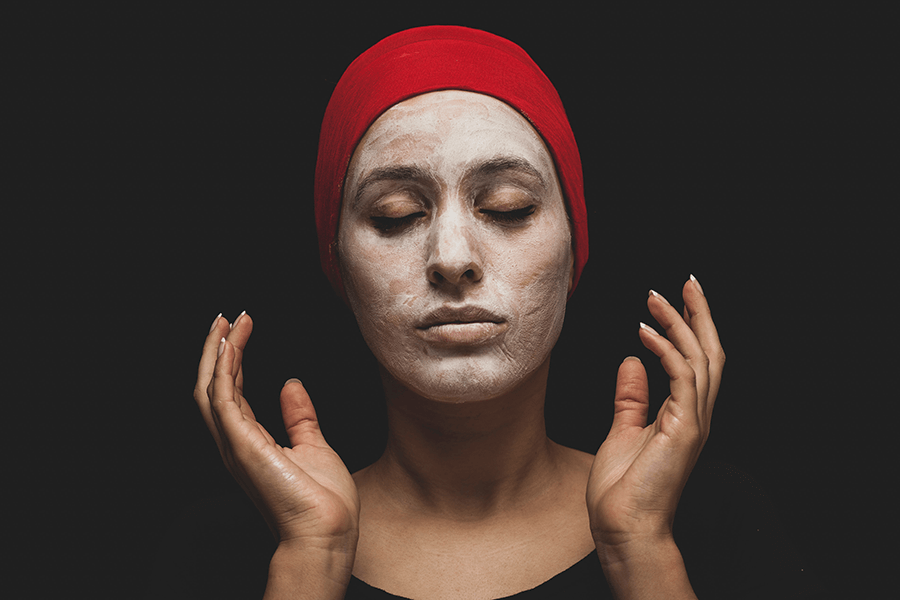
Enzymatic peeling: how it works and who it's suitable for
"For those who don't appreciate mechanical scrubs, they may give enzymatic peels a chance—a method of exfoliation that aims to remove superficial skin cells through the action of enzymes. But what are enzymes? Enzymes are proteins produced in plant and animal cells, essential for the well-being of our body because they serve as catalysts, influencing natural metabolic processes by accelerating them.
Digestive enzymes are an example of this, as their action helps break down food into basic components so that our body can easily assimilate them. Enzymes are also responsible for the ripening of fruits and vegetables; if they are too unripe, they can be challenging for us to digest.
Due to these properties, enzymes can effectively play their role as skin exfoliants. When they come into contact with the skin, a proteolytic reaction is triggered: enzymes break down the proteins that make up the skin tissues, transforming them into simple amino acids.
Epithelial cells, particularly corneocytes, are rich in a specific protein, keratin, which, once degraded into amino acids, leads to the dissolution of superficial dead cells.
The exfoliating action is not the only role performed by enzymatic peels: by penetrating the superficial layer of the skin, enzymes help eliminate impurities, clear pores from excess sebum, and achieve healthier and more compact skin. These characteristics make them particularly suitable for oily, combination, and impure skin types. However, due to their gentle action and respect for the skin's pH, enzymatic peels can be used by all skin types.
The enzymes used by cosmetic companies in the formulation of exfoliating peels can be of animal origin, such as trypsin, pepsin, and chymotrypsin, or of plant origin, which are usually the most commonly used and appreciated. Several types of enzymes in this second category are typically extracted from fruit peels or other plant parts.
The most commonly used plant enzymes in the formulations of chemical peels are papain and bromelain. The former is derived from the latex obtained from the unripe fruit of the papaya, while the latter is present in the pulp and stem of pineapple. However, proteolytic enzymes can also be found in some berries, such as raspberries, in the seeds of certain vegetables, such as pumpkin seeds, and even in cocoa.
Enzymatic peels have a different application compared to chemical scrubs; they are not to be rubbed on the skin but simply applied as a thin layer on the cleansed face. Typically available in creamy or gel formulations, the peel is then left on the face for a few minutes, usually around 10-15 minutes. However, it's advisable to follow the manufacturer's instructions, usually listed directly on the label. Afterwards, remove the peel with some lukewarm water, and voilà, your skin will appear more beautiful and radiant!
When using an enzymatic peel, it's important to take some precautions:
- Avoid the periocular area, as it is too sensitive and thin to be exfoliated with any enzymatic treatment.
- Apply a moisturizing face cream and sunscreen after performing the enzymatic peel; this will help protect the skin from sun damage.
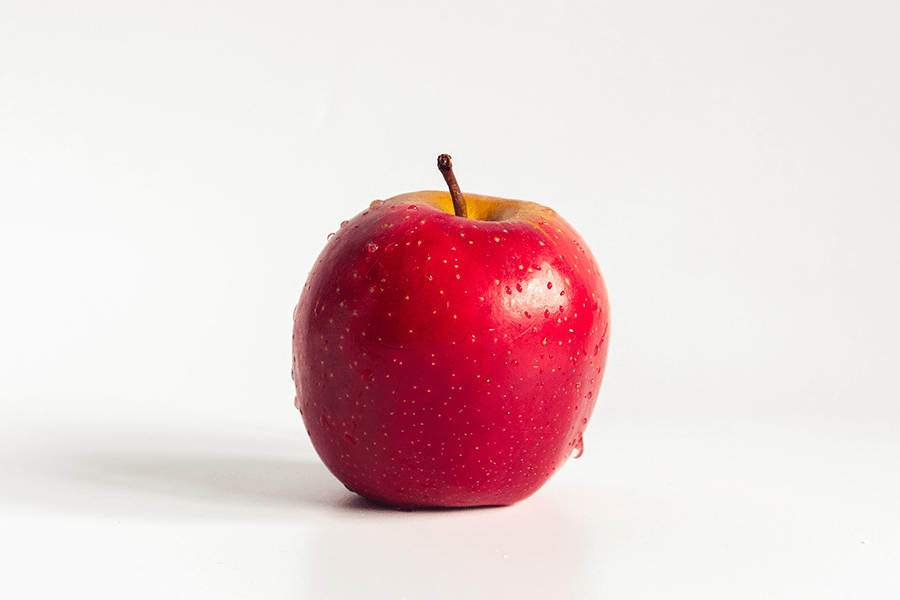
Chemical Peel: How It Works and Who It's For
The last category is that of chemical exfoliants, or chemical peels, which harness the power of certain substances, particularly acids, to break the bonds between cells and promote skin turnover.
Until not too long ago, undergoing a chemical peel required entrusting oneself to the skilled hands of specialized personnel well-versed in various types of exfoliating acids, their concentrations, and potential side effects. Today, these dermatological sessions are often sought to address specific skin imperfections such as acne or to target deep wrinkles and scars.
Today, thanks to research and advancements in the cosmetic field, it is also possible to perform a chemical exfoliation at home.
In consideration of their range of action, chemical peels can be divided into:
- Superficial or very superficial peels: exfoliates the epidermis, primarily acting on the stratum corneum and reaching at most the basal layer. It is used to remove the rough and dull layer of superficial dead cells and to address hyperpigmentation, shallow wrinkles, and small scars.
- Medium peel: acts more deeply, reaching the papillary dermis, causing inflammation. Useful for treating acne scars, melasma, and medium-depth wrinkles.
- Deep peel: its action can reach up to the reticular dermis, causing inflammation and necrosis. It is particularly indicated for deep wrinkles and scars.
If, on the other hand, we want to divide peels considering the origin of the exfoliating acids present in the solution, we have:
- Alpha-hydroxy acids or fruit acids, also known as AHAs.
- Beta-hydroxy acids or BHAs.
- Poly-hydroxy acids or PHAs.
Let's explore together what the differences are!
Alpha-hydroxy acids (AHAs)
Alpha-hydroxy acids (AHAs) are acids derived from fruits and are used in exfoliating treatments to accelerate cell turnover and counteract skin imperfections associated with photoaging. Their exfoliating action comes from weakening and breaking the bonds that hold dead cells to the underlying layers of the epidermis, allowing a new layer of skin to emerge on the surface. The result is smoother, more even, radiant skin with a younger appearance.
By exfoliating the skin, AHA peels enhance the effects and absorption of active ingredients and functional substances present in other cosmetics in our beauty routine.
The different types of AHAs, identified by their derivation, are characterized by actions that can be more or less profound and, consequently, more or less intense. Therefore, we can say that some AHAs, if present in the right concentrations, can be used even by those with sensitive and reactive skin without fearing redness, inflammation, excessive peeling, or other undesired effects.
Among the most well-known fruit acids, we have:
- Glycolic Acid: derived from sugarcane, it is the strongest of all AHAs. It is composed of small molecules that can penetrate deep into the skin layers. For this reason, it has an almost immediate action and great exfoliating power, but it is strongly discouraged for sensitive skin because it is not gentle enough.
- Lactic Acid: derived from sour milk, it has a gentler exfoliating power compared to glycolic acid.
- Mandelic Acid: extracted from bitter almonds. It acts as a gentle exfoliant and is useful in combating sun damage and hyperpigmentations. It has antimicrobial properties that make it ideal for protecting the skin from acne.
- Malic Acid: primarily obtained from apples, its exfoliating action is gentle and easily tolerated by all skin types. It improves skin smoothness and addresses fine lines without causing overly intense exfoliation.
- Tartaric Acid: present in high concentrations in grapes and tamarind, it is known for its exfoliating, brightening, and antioxidant properties. It is one of the gentlest AHAs, making it well-tolerated even by ultra-sensitive skin.
- Citric Acid: derived from citrus fruits, it combines exfoliating properties with appreciated antibacterial action, making it ideal for acne-prone skin.
Peels based on alpha-hydroxy acids can be formulated by harnessing the power of a single fruit acid or, more often, by employing the combined action of multiple AHAs, especially the milder ones, achieving a good exfoliating effect without being overly aggressive.

Beta-hydroxy acids (BHAs)
Beta-hydroxy acids (BHAs) are acids that tend to act more deeply than AHAs and are therefore less gentle. The most commonly used BHA is salicylic acid, particularly appreciated by oily and acne-prone skin because, being oil-soluble, it can penetrate clogged pores, remove excess sebum, and eliminate blackheads.
Even acne-prone skin can find salicylic acid particularly suitable for its type due to its antibacterial and anti-inflammatory properties, making it perfect for use on common pimples.
You could try BHA even if your skin suffers from rosacea: with a bit of patience and consistent application, you might notice less red and more even-toned skin.
Poly-hydroxy acids (PHAs)
Poly-hydroxy acids (PHAs) function similarly to AHAs but are characterized by larger molecules that struggle to penetrate the skin. As a result, their action remains mostly superficial and is generally slower and gentler.
They are suitable for extremely sensitive skin and for those with atopic dermatitis who fear that using a more potent acid may further irritate the skin and worsen the situation.
Among PHAs, the most commonly used ones include gluconolactone and lactobionic acid..
How to use a peel?
Chemical peels are typically characterized by a liquid or gel texture, with the latter consistency being the most recommended for its easy and quick application. Dispense the product onto a cleansed face, aiming for an even layer, just as you would with a traditional face mask.
To use your chemical peel satisfactorily, we recommend carefully reading the label and adhering scrupulously to the recommended methods.
In particular, it's important not to exceed the recommended application time because leaving an acid in contact with our skin for too long can result in overly powerful exfoliation. This may excessively thin the skin, break down its protective barriers, and cause irritation or inflammation. This advice is especially valid for stronger exfoliating acids, with glycolic acid being a notable example
As mentioned earlier for mechanical scrubs, chemical peels should never be used on the eye contour. It's best to stop at the prominence of the cheekbone and stay above the brow arch. If you accidentally overlap or if some product comes into contact with your eyes, rinse the area immediately.
As for the frequency of use, chemical peels are typically done in monthly cycles. However, in this case as well, we recommend adhering to the guidelines provided by individual cosmetic brands.
The peel can be used during the day or in the summer? It depends! Some acids are photosensitizing and are not suitable for daytime or during the summer season. This is because, by thinning the skin, they alter its natural protective barrier against UV rays, making it more susceptible to sun damage.
In general, you shouldn't run into these types of risks if you use milder AHA, BHA, or PHA. Their gentler and more skin-friendly action does not have a photosensitizing effect, so they can be used during the day, even in the summer months! However, this should not be an excuse to skip applying sunscreen, which is essential for comprehensive skin protection!

Written by Simona
She is La Saponaria’s digital writer: always juggling a newsletter to send and a blog article to publish, she lovingly takes care of our social media channels and our e-commerce.









